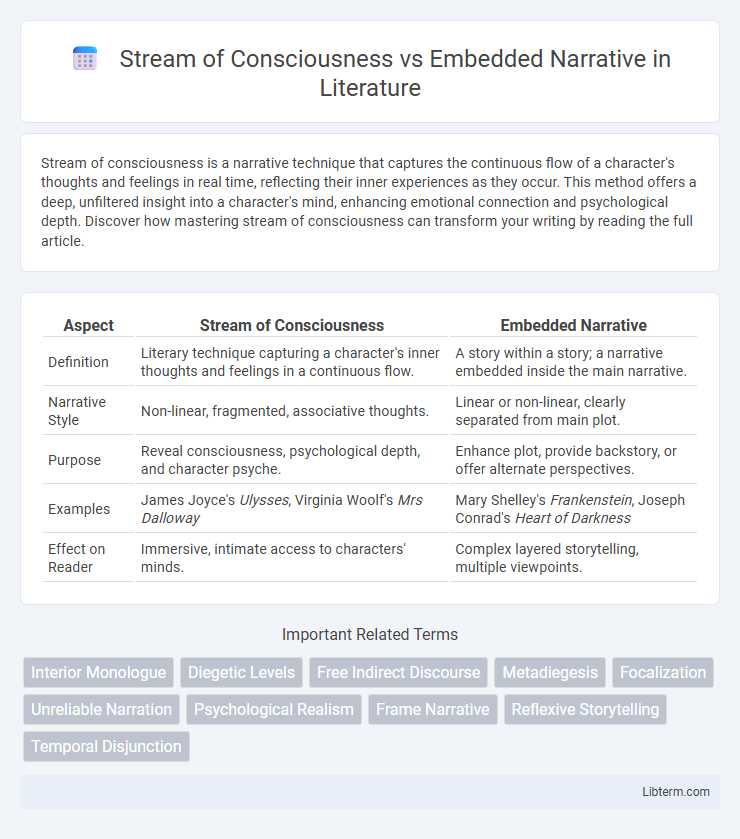Stream of consciousness is a narrative technique that captures the continuous flow of a character's thoughts and feelings in real time, reflecting their inner experiences as they occur. This method offers a deep, unfiltered insight into a character's mind, enhancing emotional connection and psychological depth. Discover how mastering stream of consciousness can transform your writing by reading the full article.
Table of Comparison
| Aspect | Stream of Consciousness | Embedded Narrative |
|---|---|---|
| Definition | Literary technique capturing a character's inner thoughts and feelings in a continuous flow. | A story within a story; a narrative embedded inside the main narrative. |
| Narrative Style | Non-linear, fragmented, associative thoughts. | Linear or non-linear, clearly separated from main plot. |
| Purpose | Reveal consciousness, psychological depth, and character psyche. | Enhance plot, provide backstory, or offer alternate perspectives. |
| Examples | James Joyce's Ulysses, Virginia Woolf's Mrs Dalloway | Mary Shelley's Frankenstein, Joseph Conrad's Heart of Darkness |
| Effect on Reader | Immersive, intimate access to characters' minds. | Complex layered storytelling, multiple viewpoints. |
Introduction to Narrative Techniques
Stream of consciousness immerses readers in a character's uninterrupted flow of thoughts, capturing psychological depth and subjective experiences. Embedded narrative involves a story within a story, providing multiple perspectives and enriching the main plot through layered storytelling. Both techniques enhance narrative complexity and deepen audience engagement by exploring different dimensions of characters and events.
Defining Stream of Consciousness
Stream of Consciousness is a narrative technique that captures a character's continuous flow of thoughts, feelings, and sensations in an unstructured, often fragmented manner. It prioritizes an internal, subjective experience over external reality, immersing readers directly into the mental processes of the protagonist. This method contrasts with Embedded Narrative, which layers stories within stories, presenting events through structured, often third-person, recounting rather than raw cognitive flow.
What is an Embedded Narrative?
An embedded narrative is a story contained within another story, often used to add depth and context to the main plot by providing background information or alternative perspectives. This technique allows authors to explore characters' inner thoughts, histories, or parallel events without disrupting the primary narrative flow. Unlike stream of consciousness, which presents a character's continuous internal thoughts and feelings, an embedded narrative offers a structured and often distinct storyline within the main story framework.
Origins and Historical Context
Stream of Consciousness originated in the early 20th century, heavily influenced by psychology and philosophy, with writers like James Joyce and Virginia Woolf pioneering this technique to capture the inner workings of the human mind. Embedded Narrative, a storytelling method dating back to ancient oral traditions and classical literature, involves a story within a story, exemplified by works such as "The Canterbury Tales" by Geoffrey Chaucer and "One Thousand and One Nights." Both narrative forms evolved to deepen character development and thematic complexity, reflecting shifts in literary modernism and postmodernism.
Key Features of Stream of Consciousness
Stream of consciousness is characterized by a continuous flow of a character's thoughts, feelings, and sensory experiences, often presented in a nonlinear, fragmented manner that mimics natural thought patterns. This technique emphasizes interior monologue, capturing spontaneous, unfiltered mental processes without traditional narrative structure or punctuation constraints. Unlike embedded narrative, which includes a story within a story, stream of consciousness delves deeply into the psyche, offering direct access to a character's subjective experience in real time.
Structural Elements of Embedded Narratives
Embedded narratives utilize a layered structure that incorporates stories within stories, often marked by shifts in narrative voice or time frame to distinguish the inner tale from the main plot. This technique relies on framing devices such as a main narrator recounting another character's story, creating a nested narrative that offers multiple perspectives and deeper thematic complexity. The structural elements of embedded narratives enhance the text's depth by juxtaposing different realities, enabling intricate character development and thematic exploration through parallel or contrasting storylines.
Major Literary Examples and Authors
Stream of consciousness prominently appears in James Joyce's *Ulysses*, Virginia Woolf's *Mrs Dalloway*, and William Faulkner's *The Sound and the Fury*, where the narrative closely mirrors characters' inner thoughts and perceptions. Embedded narrative is exemplified by Mary Shelley's *Frankenstein* and Joseph Conrad's *Heart of Darkness*, utilizing stories within stories to provide multiple perspectives and deepen thematic complexity. These techniques significantly influence narrative structure and reader engagement by shaping the flow of information and psychological depth.
Effects on Reader Experience
Stream of Consciousness immerses readers in the character's raw, unfiltered thoughts, enhancing emotional intimacy and psychological depth while often challenging linear comprehension. Embedded Narrative, by framing stories within stories, offers layered perspectives and deeper context, enriching narrative complexity and encouraging reflective engagement. Both techniques manipulate time and viewpoint but differ in immediacy and interpretative demand, shaping distinct reader experiences.
Comparative Analysis: Strengths and Limitations
Stream of consciousness offers a deep, immersive insight into characters' thoughts by presenting an unfiltered flow of mental processes, enhancing psychological depth and emotional authenticity. Embedded narrative provides structural clarity and varied perspectives through stories within stories, enabling complex plot development and thematic layering. While stream of consciousness excels in portraying subjective experience, it can confuse readers with its nonlinear and fragmented style, whereas embedded narrative risks disrupting narrative flow but supports multifaceted storytelling and contextual richness.
Conclusion: Choosing the Right Technique
Selecting between stream of consciousness and embedded narrative depends on the desired depth of character insight versus narrative structure. Stream of consciousness offers intimate access to a character's unfiltered thoughts, enhancing psychological realism and emotional immediacy. Embedded narrative provides layered storytelling and multiple perspectives, ideal for complex plots requiring clear chronological or thematic organization.
Stream of Consciousness Infographic

 libterm.com
libterm.com